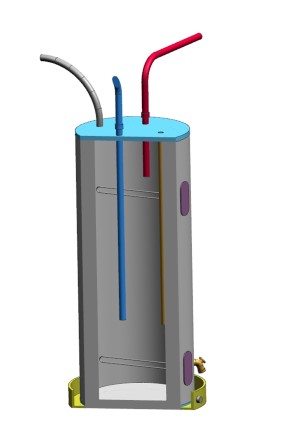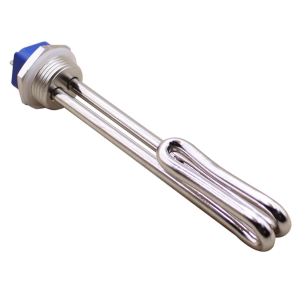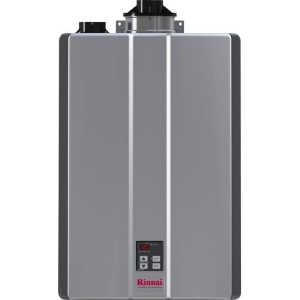- Home
- Electric Water Heaters
- Electric Heating Elements
Testing and Replacing Electric Heating Elements
A step-by-step guide to testing and replacing electric heating elements.
Uncover the common causes behind electric heating element failure, along with practical testing and repair tips.
Learn how to choose the right electric heating element for your water heater, ensuring long-lasting and efficient performance in residential use.
Understanding electric heating elements: What they are and how they work
 Electric water heater with two heating elements
Electric water heater with two heating elementsElectric heating elements in water heaters are crucial components, typically made of metals such as copper, stainless steel, titanium, and Incoloy.
They are designed to heat water efficiently through the Joule heating principle, where electrical resistance generates heat as the current passes through.
Most heaters are equipped with two elements, each controlled by a separate thermostat. These activate as needed to maintain the desired water temperature.
Positioned usually at the top and bottom of the tank, these elements directly heat the water. Safety mechanisms are in place to prevent overheating. This design ensures a consistent and efficient distribution of heat throughout the water tank, providing hot water as required.
How to choose a heating element
When selecting a replacement heating element for your electric water heater, which may have one or two elements based on its size, it's crucial to consider several key factors:
- Element flange style
- Voltage and wattage
- Watt-density
Types of heating elements
In both older and newer models of water heaters, you will find two distinct types of electric heating elements, each offering various attachment methods to the heater's body. These are:
- Flange-Type: This category includes universal flange, flat flange, and round head designs, offering versatile options for different water heater models.
- Screw-In Type: This type is characterized by its ease of installation, where the element is simply screwed into the heater's tank, providing a secure and straightforward fit.
 Heating element
Heating elementMost electric water heaters are equipped with two heating elements, an upper and a lower one, with the screw-in type being prevalent due to its ease of installation, removal, and maintenance.
Smaller capacity models, including point-of-use heaters, typically feature just one heating element. Another less commonly used type is the water heater element with a flange, also known as the bolt-in type.
Both the screw-in and flange types are immersion-type elements, designed with a U-shape to heat water efficiently when energized, achieving near 100% energy efficiency.
Manufacturers offer these elements in a range of voltages and watt densities. The most frequently encountered specifications are 240 volts and 4500 watts. To determine the specific voltage and wattage suitable for your water heater, refer to the rating plate on the unit.
Understanding thermostats: Their role in regulating temperature
Each heating element in a water heater is paired with a designated thermostat, allowing temperature adjustments typically ranging from 120°F to 140°F. This thermostat setting regulates the power output of the element, controlling the temperature of the outgoing water. If the thermostat malfunctions or fails, it can result in excessively hot water or the absence of hot water altogether.
The upper thermostat plays a pivotal role as it oversees the heating produced by both elements. It is equipped with a High Limit Switch reset button and is responsible for shutting down the heater if the temperature exceeds safe levels.
In the process of choosing the best electric water heater for your home, you will encounter options with either low or high-watt density elements.
Opt for a low-watt density heating element, as it ensures more even heat distribution and typically has a longer lifespan. An even better choice is the ultra-low watt-density element, a premium-grade option known for reducing limescale buildup and preventing dry-firing.
Diagnosing water heater element problems: A step-by-step guide
To check for issues with the heating element(s), turn on the hot water tap.
If hot water runs for only a short period before turning cold, the problem likely lies with the bottom heating element.
Even if the upper element is functioning, it will only heat water at the top of the tank, which will quickly deplete.
Conversely, if the water remains cold at the fixture, it suggests that both elements may have failed and need replacement.
What can cause heating elements to fail?
Heating elements can wear out over time due to frequent cycling on and off to maintain the water at the set temperature, regardless of whether hot water is being used or not.
Note: Remember that electric heating elements with higher wattage demand more Amps and a heavier gauge wire.
Before troubleshooting, it's crucial to understand the most common reasons for heating element failure. Always start by ensuring that the circuit breaker is on and hasn't tripped.
Additionally, pressing the reset button, located above the thermostat, may resolve the issue.
Sediment build-up problem
If you live in an area with hard water conditions, you've likely encountered problems with mineral deposits and limescale.
Sediment build-up on water heater elements hinders proper heat transfer, leading to overheating and potential element burnout.
To mitigate this issue, it's advisable to regularly clean the electric water heater element, brushing away any scale buildup.
When choosing a new water heater, consider selecting a unit with an Incoloy-type element, which offers enhanced longevity and better resistance to sediment buildup.
Additionally, a common indicator of sediment accumulation on the heating elements is a "sizzling" or "hissing" sound. This noise occurs when water, trapped next to the element, is heated to the point of producing steam.
Dryfire issue
The dry-firing problem occurs when water heater elements are exposed to air pockets while in operation. The section of the element in contact with air can overheat excessively. It only takes a few seconds for a copper heating element to burn out under these conditions, as they are designed to function only when fully submerged in water.
Dry-firing can be identified if the element's shaft becomes so annealed and soft that it can be bent with your fingers, and if the plastic around the element has melted.
To prevent this issue, it's important to always fill the electric water heater tank and bleed all air from the system before powering it on. Keep in mind that manufacturer warranties typically do not cover damage caused by dry-firing.
High voltage
If a heating element receives a voltage higher than its design specification, it will burn out. This can happen due to high voltage during lightning strikes or occasionally as a result of fluctuations from the electric utility company. Conversely, if the voltage supplied is too low, the heating element will still operate, but with reduced efficiency.
Additional issues that might impact the element's proper functioning include breakage due to vibration, an open circuit, or a split in the sheath.
Tools needed for testing and replacing
- Multimeter
- Screwdriver
- Large socket/wrench
- Garden hose
How to test a heating element in electric water heaters
To accurately test a water heater element, follow these steps:
- Power Off: Ensure the power to the water heater is turned off at the electrical panel.
- Safety Check: Use a multimeter or a non-contact voltage detector to double-check for any residual voltage on the terminals.
- Access the Element: Remove the access panel, insulation, and plastic safety cover to expose the heating element.
- Disconnect Wires: Carefully disconnect the wires from the heating element.
- Set Multimeter: Adjust your multimeter to the OHM (resistance) settings.
- Testing for Grounding: Place one test probe on a terminal and the other on the steel tank. If the multimeter's needle moves, the element is grounded and needs replacing. Ensure to test both screws of the element.
- Testing for Continuity: Position one probe on a terminal and the other on the opposite terminal. If the OHM multimeter needle doesn’t move (indicating no reading), the element is faulty and should be replaced.
A grounded element is often indicated by boiling water and frequent tripping of the circuit breaker.
Continuity through the element signifies current flow and heating capability. A functional element typically shows a reading between 10 and 16 ohms, depending on its wattage.
The absence of continuity implies an open electric circuit, preventing current flow and rendering the element inoperative.
How to replace an electric heating element on a water heater
Note: If you are not comfortable undertaking the repair yourself, always consider contacting a professional plumber.
Before starting the replacement of a broken electric water heater element, ensure you use a replacement of the same type, with identical wattage and voltage. Verify the proper rating on the element's terminal block.
Note: Make sure to check whether the circuit breaker has tripped or if a fuse is blown in the fuse box.
To properly remove and install a screw-in type heating element, which is the most commonly used type, a large socket wrench is required.
- Turn OFF the water heater at the electric service panel.
- Shut OFF the water supply and drain the tank to a level below the broken element.
- Locate the faulty electric heating element. Remove the insulation and cover to access it.
- Confirm that the power is OFF by checking for voltage at the thermostat terminals that power the element; the reading should be 0 volts.
- Disconnect the wires from the element.
- Use a large socket with a hole or wrench to remove the electric element. If it's stuck, apply more leverage with a longer tool.
- Install the new heating element with a fresh rubber gasket.
- Reconnect the wires, ensuring they are secure, clean, and free of debris and rust.
- Refill the tank (ensure the drain valve is closed and the garden hose is detached).
- Open a hot water tap until all air is expelled from the system.
- Check for any leaks.
- Restore the power to the heater.
Heating elements are crucial for water heaters as they are responsible for heating the water. A lack of functioning elements results in cold water only. While heating elements are inexpensive and their replacement can be straightforward for a handy person with basic plumbing and electrical knowledge, if you are uncomfortable with this task, it is advisable to hire a professional.
Related
- Home
- Electric Water Heaters
- Electric Heating Elements



